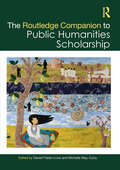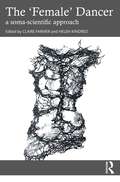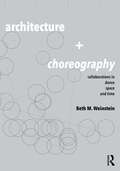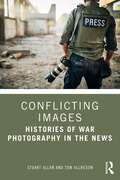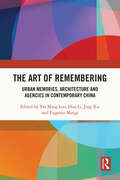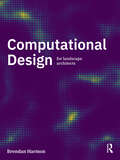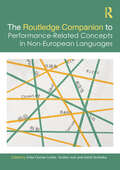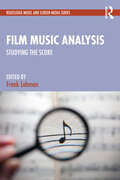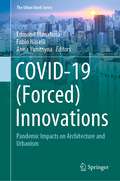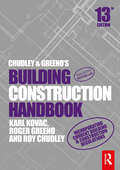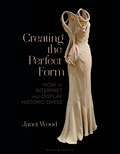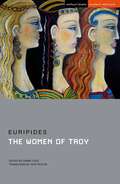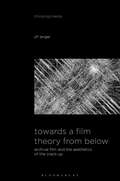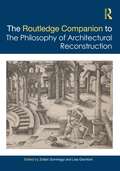- Table View
- List View
The Routledge Companion to Public Humanities Scholarship (Routledge Literature Companions)
Across humanities disciplines, public scholarship brings academics and community members and organizations together in mutually-beneficial partnership for research, teaching, and programming. While the field of publicly engaged humanities scholarship has been growing for some time, there are few volumes that have attempted to define and represent its scope. The Routledge Companion to Public Humanities Scholarship brings together wide-ranging case studies sharing perspectives on this work, grounded in its practice in the United States.The collection begins with chapters reflecting on theories and practices of public humanities scholarship. The case studies that follow are organized around six areas of particular impact in public humanities scholarship: Informing contemporary debates; amplifying community voices and histories; helping individuals and communities navigate difficult experiences; preserving culture in times of crisis and change; expanding educational access; and building and supporting public scholarship. The Companion concludes with a glossary, introducing select concepts. Taken together, these resources offer an overview for students and practitioners of public humanities scholarship, creating an accessible vocabulary rooted in the practices that have so advanced academic and community life.Although drawing on case studies from the US, these examples offer perspectives and insights relevant to public humanities around the world. This book will be of interest to anyone working within the public humanities or wanting to make their work public and engage with wider communities.
The 'Female' Dancer: a soma-scientific approach
by Claire Farmer Helen KindredThe 'Female' Dancer aims to question dancers’ relationships with ‘female’ through the examination and understandings of biological, anatomical, scientific, and self-social identity. The volume gathers voices of dance scientists, dance scholars, somatic practitioners, and dance artist-educators, to discuss some of the complexities of identities, assumptions and perceptions of a female dancing body in an intersectional and practically focused manner.The book weaves a journey between scientific and somatic approaches to dance and to dancing. Part I: 'Bodily Knowledge' explores body image, hormones and puberty, and discussions around somatic responses to the concept of the gaze. Part II: 'Moving through Change', continues to look at strength, musculature, and female fragility, with chapters interrogating practice around strength training, the dancer as an athlete, the role of fascia, the pelvic floor, pregnancy and post-partum experiences and eco-somatic perceptions of feminine. In 'Taking up Space', Part III, chapters focus on social-cultural and political experiences of females dancing, leadership, and longevity in dance. Part IV: 'Embodied Wisdom' looks at reflections of the Self, physiological, social and cultural perspectives of dancing through life, with life’s seasons from an embodied approach.Drawing together lived experiences of dancers in relationship with scientific research, this book is ideal for undergraduate students of dance, dance artists, and researchers, as well as providing dancers, dance teachers, healthcare practitioners, company managers and those in dance leadership roles with valuable information on how to support female identifying dancers through training and beyond.
The 'Female' Dancer: a soma-scientific approach
by Claire Farmer Helen KindredThe 'Female' Dancer aims to question dancers’ relationships with ‘female’ through the examination and understandings of biological, anatomical, scientific, and self-social identity. The volume gathers voices of dance scientists, dance scholars, somatic practitioners, and dance artist-educators, to discuss some of the complexities of identities, assumptions and perceptions of a female dancing body in an intersectional and practically focused manner.The book weaves a journey between scientific and somatic approaches to dance and to dancing. Part I: 'Bodily Knowledge' explores body image, hormones and puberty, and discussions around somatic responses to the concept of the gaze. Part II: 'Moving through Change', continues to look at strength, musculature, and female fragility, with chapters interrogating practice around strength training, the dancer as an athlete, the role of fascia, the pelvic floor, pregnancy and post-partum experiences and eco-somatic perceptions of feminine. In 'Taking up Space', Part III, chapters focus on social-cultural and political experiences of females dancing, leadership, and longevity in dance. Part IV: 'Embodied Wisdom' looks at reflections of the Self, physiological, social and cultural perspectives of dancing through life, with life’s seasons from an embodied approach.Drawing together lived experiences of dancers in relationship with scientific research, this book is ideal for undergraduate students of dance, dance artists, and researchers, as well as providing dancers, dance teachers, healthcare practitioners, company managers and those in dance leadership roles with valuable information on how to support female identifying dancers through training and beyond.
Architecture and Choreography: Collaborations in Dance, Space and Time
by Beth WeinsteinArchitecture and Choreography: Collaborations in Dance, Space and Time examines the field of archi-choreographic experiments—unique interdisciplinary encounters and performed events generated through collaborations between architects and choreographers.Forty case studies spanning four decades give evidence of the range of motivations for embarking on these creative endeavors and diverse conceptual underpinnings, generative methods, objects of inquiry, and outcomes. Architecture and Choreography builds histories and theories through which to examine these works, the contexts within, and processes through which the works emerged, and the critical questions they raise about ways to work together, sites and citations, ethics and equity, control and agency. Three themes frame pairs of chapters. The first addresses disciplinarity through works that critically reflect upon their discipline’s tools, techniques, and conventions juxtaposed against projects that cite or use other art forms and cultural phenomena as source material. The second interrogates space and the role of spatial dispositifs, institutions, and sites, and their hidden and not-so-hidden conditions, as conceptual drivers and structures to subvert, trouble, unsettle, remember. The third asks who and what dances, finding a spectrum from mobilized architectural bodies to more-than-human cybarcorps. Modes of collaboration and the temporalities and life cycles of projects inform bookending chapters.Architecture and Choreography offers vital lessons not only for architects and choreographers but also for students and practitioners across design and performance fields.
Architecture and Choreography: Collaborations in Dance, Space and Time
by Beth WeinsteinArchitecture and Choreography: Collaborations in Dance, Space and Time examines the field of archi-choreographic experiments—unique interdisciplinary encounters and performed events generated through collaborations between architects and choreographers.Forty case studies spanning four decades give evidence of the range of motivations for embarking on these creative endeavors and diverse conceptual underpinnings, generative methods, objects of inquiry, and outcomes. Architecture and Choreography builds histories and theories through which to examine these works, the contexts within, and processes through which the works emerged, and the critical questions they raise about ways to work together, sites and citations, ethics and equity, control and agency. Three themes frame pairs of chapters. The first addresses disciplinarity through works that critically reflect upon their discipline’s tools, techniques, and conventions juxtaposed against projects that cite or use other art forms and cultural phenomena as source material. The second interrogates space and the role of spatial dispositifs, institutions, and sites, and their hidden and not-so-hidden conditions, as conceptual drivers and structures to subvert, trouble, unsettle, remember. The third asks who and what dances, finding a spectrum from mobilized architectural bodies to more-than-human cybarcorps. Modes of collaboration and the temporalities and life cycles of projects inform bookending chapters.Architecture and Choreography offers vital lessons not only for architects and choreographers but also for students and practitioners across design and performance fields.
Conflicting Images: Histories of War Photography in the News
by Stuart Allan Tom AllbesonIn contrast with historical examinations centring the evolving role of the war correspondent, Conflicting Images focuses on the contribution of photographers and photojournalists, providing an evaluative appraisal of war photography in the news and its development from the nineteenth century to the twenty-first century.Stuart Allan and Tom Allbeson critically explore diverse genres of war photography across a broad historical sweep, encompassing events from the Crimean War (1853–56) and the Civil War in the United States (1861–65) up to and including conflicts unfolding in Syria and Ukraine. This book reflects on the relevance of different types of warfare to visual reporting, from colonial conquest via trench warfare and aerial bombardment, to the ideological dimensions of the Cold War, and ‘embedding’ and ‘winning hearts and minds’ during the ‘War on Terror’ and its aftermath. In pinpointing illustrative examples, the authors examine changing dynamics of production, dissemination, and public engagement. Readers will come to understand how current efforts to rethink the future of war photography in a digital age can benefit from a close and careful consideration of war photography’s origins, early development, and gradual, uneven transformation over the years. Conflicting Images aims to invigorate ongoing enquires and inspire new, alternative trajectories for future research and practice.This book is recommended reading for researchers and advanced students of visual journalism and conflict reporting.
The Art of Remembering: Urban Memories, Architecture and Agencies in Contemporary China
by Hua Li Jing Xie Yat Ming Loo Eugenio MangiFocusing on the non-Western context and case studies, this book explores theories of interdisciplinary architectural thinking and the construction of urban memory in Chinese cities, with an emphasis on contemporary architecture and the diversity of agencies.China has undergone one of the fastest urbanisation and urban renewal processes in human history, but discussions of urban memory in China have tended to be practice-oriented and lack theoretical reflection. This book brings together interdisciplinary architectural scholarship to interrogate the production of urban memory and examine experiences in China. The 14 chapters explore different processes, projects, materials, architecture and urban spaces in different Chinese cities by analysing cityscapes such as temples, bridges, conservation projects, architectural design, historical architecture, memorial hall, market street, city images, custom bike, food market and so on. The book deals with different agencies and methods, tangible and intangible, in the construction of memories aimed at promoting hybridised multiple identities, and explores the interplay of different versions of memory, i.e. state, public, regional, local, individual and collective memory.This book will be essential reading for scholars and students of architecture and urbanism, cultural studies and China studies, as well as architects, urban planners and historians interested in these fields.
The Art of Remembering: Urban Memories, Architecture and Agencies in Contemporary China
by Hua Li Jing Xie Yat Ming Loo Eugenio MangiFocusing on the non-Western context and case studies, this book explores theories of interdisciplinary architectural thinking and the construction of urban memory in Chinese cities, with an emphasis on contemporary architecture and the diversity of agencies.China has undergone one of the fastest urbanisation and urban renewal processes in human history, but discussions of urban memory in China have tended to be practice-oriented and lack theoretical reflection. This book brings together interdisciplinary architectural scholarship to interrogate the production of urban memory and examine experiences in China. The 14 chapters explore different processes, projects, materials, architecture and urban spaces in different Chinese cities by analysing cityscapes such as temples, bridges, conservation projects, architectural design, historical architecture, memorial hall, market street, city images, custom bike, food market and so on. The book deals with different agencies and methods, tangible and intangible, in the construction of memories aimed at promoting hybridised multiple identities, and explores the interplay of different versions of memory, i.e. state, public, regional, local, individual and collective memory.This book will be essential reading for scholars and students of architecture and urbanism, cultural studies and China studies, as well as architects, urban planners and historians interested in these fields.
Conflicting Images: Histories of War Photography in the News
by Stuart Allan Tom AllbesonIn contrast with historical examinations centring the evolving role of the war correspondent, Conflicting Images focuses on the contribution of photographers and photojournalists, providing an evaluative appraisal of war photography in the news and its development from the nineteenth century to the twenty-first century.Stuart Allan and Tom Allbeson critically explore diverse genres of war photography across a broad historical sweep, encompassing events from the Crimean War (1853–56) and the Civil War in the United States (1861–65) up to and including conflicts unfolding in Syria and Ukraine. This book reflects on the relevance of different types of warfare to visual reporting, from colonial conquest via trench warfare and aerial bombardment, to the ideological dimensions of the Cold War, and ‘embedding’ and ‘winning hearts and minds’ during the ‘War on Terror’ and its aftermath. In pinpointing illustrative examples, the authors examine changing dynamics of production, dissemination, and public engagement. Readers will come to understand how current efforts to rethink the future of war photography in a digital age can benefit from a close and careful consideration of war photography’s origins, early development, and gradual, uneven transformation over the years. Conflicting Images aims to invigorate ongoing enquires and inspire new, alternative trajectories for future research and practice.This book is recommended reading for researchers and advanced students of visual journalism and conflict reporting.
Computational Design for Landscape Architects
by Brendan HarmonThis book is a guide to computational design for landscape architects replete with extensive tutorials. It introduces algorithmic approaches for modeling and designing landscapes. The aim of this book is to use algorithms to understand and design landscape as a generative system, i.e. to harness the processes that shape landscape to generate new forms. An algorithmic approach to design is gently introduced through visual programming with Grasshopper, before more advanced methods are taught in Python, a high-level programming language. Topics covered include parametric design, randomness and noise, waves and attractors, lidar, drone photogrammetry, point cloud modeling, terrain modeling, earthworks, digital fabrication, and more. The chapters include sections on theory, methods, and either visual programming or scripting. Online resources for the book include code and datasets so that readers can easily follow along and try out the methods presented. This book is a much-needed guide, both theoretical and practical, on computational design for students, educators, and practitioners of landscape architecture.
The Routledge Companion to Performance-Related Concepts in Non-European Languages (ISSN)
Investigating more than 70 key concepts relating to the performing arts in more than six non-European languages, this volume provides a groundbreaking research tool and one-of-a-kind reference source for theatre, performance and dance studies worldwide.The Companion features in-depth explorations of and expert introductions to a select number of performance-related key concepts in Arabic, Chinese, Japanese, Korean, Yorùbá as well as the Indian languages Sanskrit, Hindi and Tamil. Key concepts—such as Furǧa فرجة in Arabic, for example, or Jiadingxing 假定性 in Chinese, Gei 芸 in Japanese, Ìparadà in Yorùbá and Imyeon 이면 in Korean—that defy easy translation from one language to another (and especially into English as the world’s lingua franca) and that reflect culturally specific ways of thinking and talking about the performing arts are thoroughly examined in in-depth articles. Written by more than 60 distinguished scholars from around the globe, the articles describe in detail each concept’s dynamic history, its flexible scope of meaning and current range of usage. The Companion also includes extensive introductions to each language section, in which internationally renowned experts explain how the presented key concepts are situated within, and are constitutive of, distinct and dynamic epistemic systems that have different yet always interlinked histories and orientations. Offers a fascinating insight into the unique histories, characteristics, and orientations of linguistically and culturally distinct epistemic systems related to the performative arts Contains extensive cross-references and bibliographies An invaluable research tool and one-of-a-kind reference source for scholars and students worldwide and across the humanities, especially in the fields of theatre, performance, dance, translation, area and cultural studies An accessible handbook for everybody interested in performance cultures and performance-related knowledge systems existing in the world today. This volume provides an invaluable research tool and one-of-a-kind reference source for scholars and students worldwide and across the humanities, especially in the fields of theatre, performance, dance, translation and area studies, history (of science and the humanities) and cultural studies.
Computational Design for Landscape Architects
by Brendan HarmonThis book is a guide to computational design for landscape architects replete with extensive tutorials. It introduces algorithmic approaches for modeling and designing landscapes. The aim of this book is to use algorithms to understand and design landscape as a generative system, i.e. to harness the processes that shape landscape to generate new forms. An algorithmic approach to design is gently introduced through visual programming with Grasshopper, before more advanced methods are taught in Python, a high-level programming language. Topics covered include parametric design, randomness and noise, waves and attractors, lidar, drone photogrammetry, point cloud modeling, terrain modeling, earthworks, digital fabrication, and more. The chapters include sections on theory, methods, and either visual programming or scripting. Online resources for the book include code and datasets so that readers can easily follow along and try out the methods presented. This book is a much-needed guide, both theoretical and practical, on computational design for students, educators, and practitioners of landscape architecture.
The Routledge Companion to Performance-Related Concepts in Non-European Languages (ISSN)
by Erika Fischer-Lichte Torsten Jost Astrid SchenkaInvestigating more than 70 key concepts relating to the performing arts in more than six non-European languages, this volume provides a groundbreaking research tool and one-of-a-kind reference source for theatre, performance and dance studies worldwide.The Companion features in-depth explorations of and expert introductions to a select number of performance-related key concepts in Arabic, Chinese, Japanese, Korean, Yorùbá as well as the Indian languages Sanskrit, Hindi and Tamil. Key concepts—such as Furǧa فرجة in Arabic, for example, or Jiadingxing 假定性 in Chinese, Gei 芸 in Japanese, Ìparadà in Yorùbá and Imyeon 이면 in Korean—that defy easy translation from one language to another (and especially into English as the world’s lingua franca) and that reflect culturally specific ways of thinking and talking about the performing arts are thoroughly examined in in-depth articles. Written by more than 60 distinguished scholars from around the globe, the articles describe in detail each concept’s dynamic history, its flexible scope of meaning and current range of usage. The Companion also includes extensive introductions to each language section, in which internationally renowned experts explain how the presented key concepts are situated within, and are constitutive of, distinct and dynamic epistemic systems that have different yet always interlinked histories and orientations. Offers a fascinating insight into the unique histories, characteristics, and orientations of linguistically and culturally distinct epistemic systems related to the performative arts Contains extensive cross-references and bibliographies An invaluable research tool and one-of-a-kind reference source for scholars and students worldwide and across the humanities, especially in the fields of theatre, performance, dance, translation, area and cultural studies An accessible handbook for everybody interested in performance cultures and performance-related knowledge systems existing in the world today. This volume provides an invaluable research tool and one-of-a-kind reference source for scholars and students worldwide and across the humanities, especially in the fields of theatre, performance, dance, translation and area studies, history (of science and the humanities) and cultural studies.
Film Music Analysis: Studying the Score (Routledge Music and Screen Media Series)
Since the establishment of film music studies, there has been a steady growth of serious analytical work on the film music repertoire. Film Music Analysis: Studying the Score offers the first collection of essays dedicated to the close investigation of musical structure and meaning in film music. Showcasing scholarship from a diverse and distinguished group of music theorists and musicologists, this book presents the many ways to inspect the inner workings of film music in a manner that is exciting and accessible to anyone curious about this music, regardless of their background in film or music theory.Each chapter takes as its focus one music-theoretical parameter and explores how that concept can be used to analyze and interpret film music. Covering theoretical concepts that range from familiar categories such as leitmotif and pitch structure to more cutting-edge ideas such as timbral associativity, topic theory, and metrical states, the book provides a toolkit with which to explore this captivatingly varied repertoire. With example analyses drawn from classic and contemporary films, Film Music Analysis: Studying the Score is a valuable teaching tool and an indispensable addition to the library of any lover of film and music.
COVID-19: Pandemic Impacts on Architecture and Urbanism (The Urban Book Series)
by Anna Yunitsyna Edmond Manahasa Fabio NaselliThis book gives an overview of the shifting paradigm from traditional design techniques and standards to new values and methods that occurred in response to confronting the COVID-19 pandemic. The theoretical studies of the phenomenon of "new normality" in architecture, urbanism and social sciences are a source of knowledge for researchers, professors and students in the fields of architecture, urbanism and interior design. On-site applications of post-COVID-19 structures will be interesting for students, practitioners, developers and city managers. The issue of online design teaching and learning provides a set of practices that can be applied by both educators and trainees. The book also is useful for readers who are interested in recent trends in architecture and interior design: it provides a deep analysis of recent changes in architecture, which aim to make the environment disease-free and the space habitable during the long periods of lockdown.
Film Music Analysis: Studying the Score (Routledge Music and Screen Media Series)
by Frank LehmanSince the establishment of film music studies, there has been a steady growth of serious analytical work on the film music repertoire. Film Music Analysis: Studying the Score offers the first collection of essays dedicated to the close investigation of musical structure and meaning in film music. Showcasing scholarship from a diverse and distinguished group of music theorists and musicologists, this book presents the many ways to inspect the inner workings of film music in a manner that is exciting and accessible to anyone curious about this music, regardless of their background in film or music theory.Each chapter takes as its focus one music-theoretical parameter and explores how that concept can be used to analyze and interpret film music. Covering theoretical concepts that range from familiar categories such as leitmotif and pitch structure to more cutting-edge ideas such as timbral associativity, topic theory, and metrical states, the book provides a toolkit with which to explore this captivatingly varied repertoire. With example analyses drawn from classic and contemporary films, Film Music Analysis: Studying the Score is a valuable teaching tool and an indispensable addition to the library of any lover of film and music.
Chudley and Greeno's Building Construction Handbook
by Roy Chudley Roger Greeno Karl KovacThe 13th edition of Chudley and Greeno’s Building Construction Handbook remains THE authoritative reference for all construction students and professionals. The principles and processes of construction are explained with the concepts of design included where appropriate. Extensive coverage of building construction practice, techniques and regulations representing both traditional procedures and modern developments are included to provide the most comprehensive and easy-to-understand guide to building construction.This new edition has been updated to reflect recent changes to the Building Regulations, as well as including new material on modern methods of construction, greater emphasis on sustainability, health and safety, and coverage of heat pumps, photovoltaics, underfloor heating and rainwater harvesting.Chudley and Greeno’s Building Construction Handbook is the essential, easy-to-use resource for undergraduate and vocational students on a wide range of courses including NVQ and BTEC National, through to Higher National Certificate and Diploma, to Foundation and three-year degree level. It is also a useful practical reference for building designers, contractors and others engaged in the construction industry.
Chudley and Greeno's Building Construction Handbook
by Roy Chudley Roger Greeno Karl KovacThe 13th edition of Chudley and Greeno’s Building Construction Handbook remains THE authoritative reference for all construction students and professionals. The principles and processes of construction are explained with the concepts of design included where appropriate. Extensive coverage of building construction practice, techniques and regulations representing both traditional procedures and modern developments are included to provide the most comprehensive and easy-to-understand guide to building construction.This new edition has been updated to reflect recent changes to the Building Regulations, as well as including new material on modern methods of construction, greater emphasis on sustainability, health and safety, and coverage of heat pumps, photovoltaics, underfloor heating and rainwater harvesting.Chudley and Greeno’s Building Construction Handbook is the essential, easy-to-use resource for undergraduate and vocational students on a wide range of courses including NVQ and BTEC National, through to Higher National Certificate and Diploma, to Foundation and three-year degree level. It is also a useful practical reference for building designers, contractors and others engaged in the construction industry.
Creating the Perfect Form: How to Interpret and Display Historic Dress
by Ms Janet WoodHow can the cut of a 19th century gown control its shape? Can you re-create a historic profile from a contemporary mannequin? How can paintings help you analyse historic silhouettes and the corsets and petticoats worn underneath? Conservation and historic dress display specialist Janet Wood will help you answer all these questions. You'll learn how historic garments can be safely handled and shown to best effect, with insight into the characteristic features of each piece and how to translate them from the garment to a display support.Concentrating on Western women's wear from 1750–1950, and with over 250 colour images, plus drawings and charts, you'll learn how to interpret an individual garment's display needs and create safe, appropriate display forms.
The Women of Troy (Student Editions)
by EuripidesThere's no decent way to say an indecent thingAn industrial port of a war-torn city. Women survivors wait to be shipped abroad. Officials come and go. A grandmother, once queen, watches as her remaining family are taken from her one by one. The city burns around them. First performed in 415BC, the play focuses on the human cost of war and the impact of loss.This new Student Edition of The Women of Troy includes a commentary and notes by Emma Cole, which looks at the Trojan War as represented in Greek literature and myth; the context in which Euripides was writing and within which the play was first performed; how it would have been originally staged and dramaturgical challenges met; as well as recent performance history of the play, including Katie Mitchell's iconic 2007 production at the National Theatre. Euripides' great anti-war play is published here in Don Taylor's classic translation.
The Women of Troy (Student Editions)
by EuripidesThere's no decent way to say an indecent thingAn industrial port of a war-torn city. Women survivors wait to be shipped abroad. Officials come and go. A grandmother, once queen, watches as her remaining family are taken from her one by one. The city burns around them. First performed in 415BC, the play focuses on the human cost of war and the impact of loss.This new Student Edition of The Women of Troy includes a commentary and notes by Emma Cole, which looks at the Trojan War as represented in Greek literature and myth; the context in which Euripides was writing and within which the play was first performed; how it would have been originally staged and dramaturgical challenges met; as well as recent performance history of the play, including Katie Mitchell's iconic 2007 production at the National Theatre. Euripides' great anti-war play is published here in Don Taylor's classic translation.
Creating the Perfect Form: How to Interpret and Display Historic Dress
by Ms Janet WoodHow can the cut of a 19th century gown control its shape? Can you re-create a historic profile from a contemporary mannequin? How can paintings help you analyse historic silhouettes and the corsets and petticoats worn underneath? Conservation and historic dress display specialist Janet Wood will help you answer all these questions. You'll learn how historic garments can be safely handled and shown to best effect, with insight into the characteristic features of each piece and how to translate them from the garment to a display support.Concentrating on Western women's wear from 1750–1950, and with over 250 colour images, plus drawings and charts, you'll learn how to interpret an individual garment's display needs and create safe, appropriate display forms.
Towards a Film Theory from Below: Archival Film and the Aesthetics of the Crack-Up (Thinking Media)
by Jiri AngerOperating between film theory, media philosophy, archival practice, and audiovisual research, Jiri Anger focuses on the relationship between figuration and materiality in early films, experimental found footage cinema, and video essays. Would it be possible to do film theory from below, through the perspective of moving-image objects, of their multifarious details and facets, however marginal, unintentional, or aleatory they might be? Could we treat scratches, stains, and shakes in archival footage as speculatively and aesthetically generative features? Do these material actors have the capacity to create “weird shapes” within the figurative image that decenter, distort, and transform the existing conceptual and methodological frameworks?Building on his theoretical as well as practical experience with the recently digitized corpus of the first Czech films, created by Jan Kríženecký between 1898 and 1911, the author demonstrates how technological defects and accidents in archival films shape their aesthetic function and our understanding of the materiality of film in the digital age. The specific clashes between the figurative and material spheres are understood through the concept of a “crack-up.” This term, developed by Francis Scott Fitzgerald and theoretically reimagined by Gilles Deleuze, allows us to capture the convoluted relationship between figuration and materiality as inherent to the medium of film, containing negativity and productivity, difference and simultaneity, contingency and fate, at the same time, even within the tiniest cinematic units.
Towards a Film Theory from Below: Archival Film and the Aesthetics of the Crack-Up (Thinking Media)
by Jiri AngerOperating between film theory, media philosophy, archival practice, and audiovisual research, Jiri Anger focuses on the relationship between figuration and materiality in early films, experimental found footage cinema, and video essays. Would it be possible to do film theory from below, through the perspective of moving-image objects, of their multifarious details and facets, however marginal, unintentional, or aleatory they might be? Could we treat scratches, stains, and shakes in archival footage as speculatively and aesthetically generative features? Do these material actors have the capacity to create “weird shapes” within the figurative image that decenter, distort, and transform the existing conceptual and methodological frameworks?Building on his theoretical as well as practical experience with the recently digitized corpus of the first Czech films, created by Jan Kríženecký between 1898 and 1911, the author demonstrates how technological defects and accidents in archival films shape their aesthetic function and our understanding of the materiality of film in the digital age. The specific clashes between the figurative and material spheres are understood through the concept of a “crack-up.” This term, developed by Francis Scott Fitzgerald and theoretically reimagined by Gilles Deleuze, allows us to capture the convoluted relationship between figuration and materiality as inherent to the medium of film, containing negativity and productivity, difference and simultaneity, contingency and fate, at the same time, even within the tiniest cinematic units.
The Routledge Companion to the Philosophy of Architectural Reconstruction
by Lisa Giombini Zoltán SomhegyiThis companion investigates the philosophical and theoretical foundations determining the conditions of possibility and the limits that make the conservation, readaptation, and transformation of past buildings legitimate operations.As increasing ecological and economic challenges question opportunities for new construction, the process of restoring, transforming, and readapting buildings for new or continued use is becoming an essential part of architectural practice. At the same time, the role of building conservation is changing from mere material preservation to being part of a broader strategy for social regeneration, eco-awareness, and inclusive urban planning. Chapters of this volume explore the complex set of considerations that inform decisions to merely preserve, accurately restore or variously reuse a building. They also look at the broader philosophical concerns such as ethical and aesthetic values, combined with ideas of heritage, history, and collective identity. Case studies on reconstruction after war, gentrification, the restoration of ancient edifices, reconstruction following the effects of climate change, and the use of technology solutions among many others, make this a timely and urgent volume.Adopting a broad transcultural perspective with contributions from five continents, the volume combines theoretical approaches with more practical, case study-based investigations and will be of great interest to upper-level students and academics working in the fields of architecture, conservation, urban design, aesthetics, and heritage management.
